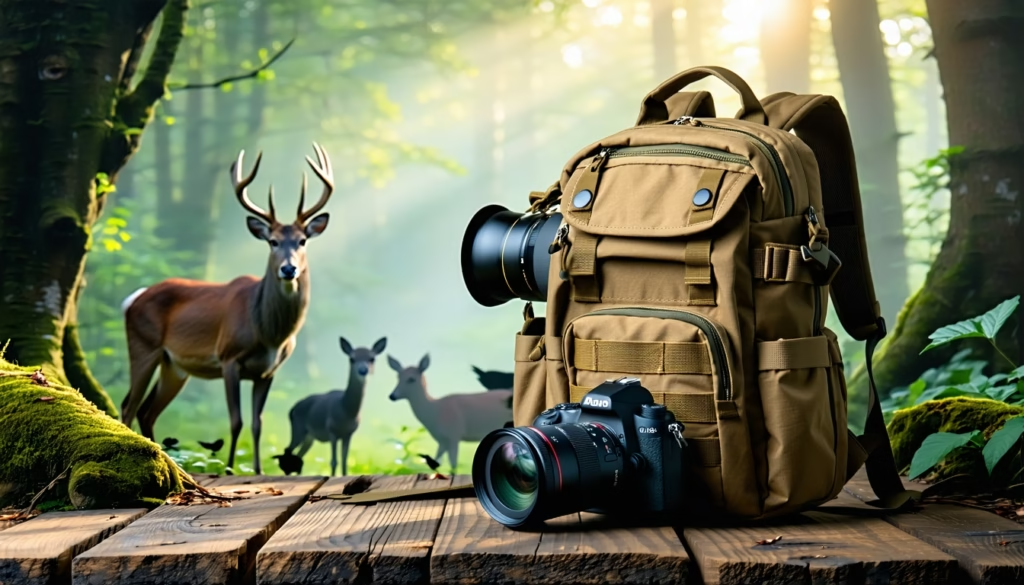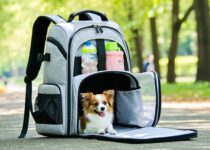The Best Camera Backpack Options For Wildlife Photography

When you’re perched at the edge of a muddy riverbank, camera in hand, waiting for that perfect heron shot, the last thing you want is fumbled gear. Picking the best camera backpack options for wildlife photography means your lenses, bodies, tripod, and accessories stay safe, dry, and right at your fingertips.
In this guide, you’ll get clear pointers on choosing a pack built for rugged terrain and changing weather, plus a roundup of top models—from budget-friendly runners to pro-level haulers. You’ll learn what padding, fit, weatherproofing, and price tier works for your setup, so you can focus on spotting birds, mammals, or insects without worrying about your bag.
Choose Your Backpack Type
What makes a wildlife pack different from your everyday daypack? A camera backpack designed for wildlife photography blends protective compartments with hiking-style features.
- Dedicated camera compartments, so your lenses and bodies don’t jostle
- Side or back panel access for quick lens swaps when a subject appears
- Tripod straps or sleeves, to secure your support on the move
- Hydration bladder compatibility and hip belts, like a hiking pack
If you’re used to a general daypack, check out the key contrasts in our guide on the difference between hiking and camera backpacks. That deep dive helps you spot the camera-specific tweaks—like reinforced bottoms and modular dividers—that matter out in the field.
Evaluate Protection Features
Your gear is an investment. You’ll want padding and divider systems that shield fragile glass and electronics from bumps and drops.
Core protection points to consider:
- Impact-resistant foam around camera chambers
- Customizable dividers, so each lens or body has its own snug spot
- Lockable zipper pulls for security
- Built-in rain cover or compatibility with aftermarket covers
For a full rundown of must-have compartments, see essential features every photographer should want in a backpack. That guide walks you through airflow channels, top-lid access and hidden pockets for memory cards or keys.
Consider Comfort And Fit
A heavy load combined with rough terrain can leave you stiff and sore. The right suspension system keeps you shooting, not limping.
Watch for:
- Ergonomic harness with load-lifter straps, to balance weight on your hips
- Padded hip belt, so shoulders don’t bear the full load
- Breathable mesh back panel, for better airflow on long hikes
- Adjustable torso length, to match your height
If you’re fighting back pain on every trek, check tips on how to prevent back pain when carrying camera gear. A few simple harness tweaks can cut discomfort and let you focus on that perfect frame.
Assess Weatherproofing Options
Rain, dust and even accidental splashes can ruin your day. Weatherproofing keeps moisture and grit out where you don’t want it.
Key weatherproofing elements:
- Durable water-resistant fabric, like nylon or polyester with PU coating
- Sealed or taped seams around zipper areas
- Built-in rain cover stored in a bottom pocket
- Water-resistant zipper sliders and flaps
Many top packs include their own rain shield, but you can also enhance protection—see what to look for in a waterproof camera backpack for materials and design tips. You may also like our advice on camera backpacks with built-in rain covers to keep water at bay.
Compare Price Options
Your wallet and your shooting style both matter. Here’s how pricing tiers typically shake out:
- Budget (Under $100): Basic padding, limited compartments, lightweight
- Mid-range ($100–$300): Solid weatherproofing, modular dividers, comfort straps
- Premium ($300+): Pro-grade materials, advanced harness system, extra features
If you’re starting out or watching costs, take a peek at our roundup of top affordable camera backpacks under $100. For seasoned pros looking for space and durability, browse best large camera backpacks for professionals.
Review Top Backpack Models
Here’s a side-by-side look at six standout packs for wildlife photography. We’ve covered a range of sizes, price points and feature sets so you can spot your ideal match at a glance.
| Model | Capacity | Weight | Price | Key Features | Best For |
|---|---|---|---|---|---|
| Lowepro ProTactic BP 350 AW II | 15 L | 3.3 lbs | $200 | All-Weather Cover, Modular Interior, Tripod Mount | Wildlife Pros |
| MindShift Rotation180 Professional | 26 L | 3.7 lbs | $220 | 360° Rotating Waist Belt, Side Access, Weather Shield | Fast Lens Swaps |
| F-Stop Ajna 28L | 28 L | 3.4 lbs | $250 | ICU Modular System, Tripod Straps, Hydration Compatible | Multi-Day Treks |
| Tenba Solstice Backpack 20L | 20 L | 3.1 lbs | $179 | TPU-Coated, Padded Dividers, Water-Resistant Zippers | Budget Shooters |
| Vanguard Alta Sky 45D | 45 L | 4.9 lbs | $230 | Advanced Harness, Side Door, External Pocket | Heavy Gear Hauls |
| Peak Design Everyday Backpack 30L | 30 L | 3.0 lbs | $260 | Quick Side Access, Weatherproof Shell, FlexFold Dividers | Urban Meets Wild |
Lowepro ProTactic BP 350 AW II
This pack is a field workhorse. It offers a custom interior for up to two camera bodies, four to five lenses, plus space for a 13″ laptop. The all-weather cover and built-in tripod straps mean you’re ready for rain or rocky trails. Ideal for wildlife pros carrying multiple bodies.
MindShift Rotation180 Professional
A game changer when speed matters. The waist-belt pouch rotates 360 degrees so you can grab your camera without taking the pack off. It holds a DSLR, three lenses and extras in the main compartment, with room for hydration gear. Perfect if quick lens swaps can make or break your shot.
F-Stop Ajna 28L
Built around F-Stop’s ICU (internal camera unit) system, this pack adapts to whatever gear you pack. The stretchiest harness system handles long treks, and tripod straps sit low to avoid swinging. Check out our picks for best large camera backpacks for professionals if you need even more space.
Tenba Solstice Backpack 20L
A smart budget choice. You get solid weather resistance, padded dividers and side access panels, all at a beginner-friendly price. It fits one DSLR with 2–3 lenses plus small accessories. See our guide on top affordable camera backpacks under $100 for more budget-minded options.
Vanguard Alta Sky 45D
When your kit grows, this 45 L pack stands up. The harness system molds to your back, and a side-opening door lets you snag gear on the go. External pockets keep filters and cables handy, making it a good fit for those with heavy wildlife lens libraries.
Peak Design Everyday Backpack 30L
Known for clean design and quick access. Its weatherproof shell sheds drizzle while FlexFold dividers adapt to any layout you need. Side-loading panels give camera access without laying the pack on muddy ground. A versatile choice if you split time between wild trails and city streets.
Frequently Asked Questions:
What size backpack do I need for wildlife photography?
For most users, 20–30 L is ideal—it holds a camera body, a couple of telephoto lenses, plus your essentials. If you carry two bodies or extra accessories for multi-day trips, bump up to 30–45 L.
How do I keep my lenses scratch-free inside a backpack?
Always use padded dividers and keep each lens in its own compartment. Slip on lens caps and rear caps, then consider a simple cloth wrap between lenses. For more tips see tips for keeping lenses scratch-free inside a backpack.
Can I use a wildlife backpack for hiking trips?
Yes—many wildlife packs double as hiking backpacks once you remove or reorganize the camera ICU. Compare key differences in the difference between hiking and camera backpacks to see what you gain or lose.
How should I carry a tripod on my backpack?
Most models have side or front straps that cradle your tripod legs. Angle the head down to keep it stable. For extra stability and gear protection, check our guide on how to carry a tripod using a camera backpack.
Are waterproof backpacks necessary in the field?
If you shoot in rainy or dusty environments, yes. A water-resistant shell and taped seams can stop moisture. Many packs also include a rain cover—see what to look for in a waterproof camera backpack for key features.
How do I clean and maintain my camera backpack?
Empty all gear, then brush out dirt and shake loose debris. Wipe down the interior with a damp cloth and mild soap, rinse covers and straps, and air-dry away from direct sun. More step-by-step care tips are in how to clean and maintain a camera backpack.
Conclusion
Your ideal wildlife photography backpack balances protection, comfort and weather resistance within your budget. Whether you pick a compact 20 L pack for short excursions or a robust 45 L pro model for extended safaris, focus on features that match how you shoot and where you roam.
Now that you’re armed with key comparisons and top model picks, you can choose a pack that feels like part of your kit—not just another bag. Happy shooting, and may your next wildlife encounter be your best one yet.


